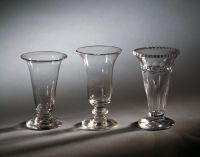Cut Jelly Glasses
Artist/Maker: Unknown
Created: late 18th century
Origin/Purchase: England
Materials: glass
Dimensions: H: 10.8 (4 1/4 in.); D (rim): 6.4 (2 1/2 in.)
Location: Dining Room
Provenance: Thomas Jefferson; by descent to Margaret Randolph Taylor and Olivia Alexander Taylor; by bequest to the Thomas Jefferson Foundation in 1985
Accession Number: 1986-31-11 and 12
Historical Notes: At the end of his stay in France, Jefferson copied several of his favorite recipes. One of them explained how to make "Wine jellies." Boiled calves-feet or isinglass was combined with egg whites and a pint of madeira. The mixture was sweetened and flavored with lemon, cloves, and nutmeg. "Strain it 2 or 3 times thro' a flannel till clear," wrote Jefferson; then, "Put it in glasses or moulds."[1]
In the eighteenth and early nineteenth century, the second course of dinner typically featured a number of sweet dishes such as cakes, custards, creams, and jellies. Although sometimes made in large, elaborate molds, jellies served in individual glasses were equally popular. Round, trumpet-shaped, and footed jelly glasses corresponded to other fashionable glassware in shape and decoration.[2]
Three different styles of Monticello glasses are known. Two are plain free-blown glasses, one with a knopped stem. The third type of free-blown jelly glass, shown here, has cut decoration on the rim and bowl.
On August 18, 1791, in New York, Jefferson wrote in his memorandum book, "Pd. for jelly glasses 3. doz. 3 [dollars]."[3] Among the items inventoried at Monticello after his death were "21 cut & 3 plain jelly glasses."[4]
-Text from Stein, Worlds, 339
References
- ^ Jefferson, "Wine jellies," undated, Thomas Jefferson Papers, Library of Congress.
- ^ Louise Conway Belden, The Festive Tradition: Table Decoration and Desserts in America, 1650-1900 (New York: W.W. Norton & Co., 1983), 55, 158.
- ^ Jefferson, August 18, 1791, MB, 2:830. Transcription available at Founders Online.
- ^ [Martha Jefferson Randolph?], "Inventory of the furniture in the house at Monticello," Coolidge Collection of Thomas Jefferson Manuscripts, Massachusetts Historical Society.
